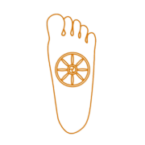The family group has collectively decided to take a look at one of the quintessential buddhist teachings: the Four Noble Truths. This is not an easy topic to cover, and even those who have devoted their whole lives to buddhist practice have not exhausted their exploration of the topic. But at its core the Four Noble Truths are not just philosophy – they deal with the very nature of truth and reveal to us things and processes happening in everyday life. So that’s where we started, by looking at What is Truth?
It’s not enough to say that these four things are truths. There are thousands of things in the world claiming to be truth. And many of them have an aspect of truth to them. But to really appreciate what the Buddha pointed out, we have to distinguish between things that are true sometimes or in certain situations, and things that are universally true – true all the time to all people.
ACTIVITY: To begin we did an activity where everyone closed their eyes and held out their hands, and one person gave each a different object. A watering can, a lighter, a pair of scissors, a measuring tape, a timer, etc. They got to feel the object but couldn’t look at it. Then they put the object down behind them and everyone opened their eyes. The rest of the group could see their object but they couldn’t, and they had to describe it. Most were able to figure out what their object was, but some couldn’t because they had never experienced anything like it.
What we all really wanted was to know what the object was. That’s called Perception, or having a label and story for an object. But if we aren’t able to get that, then we have to just feel it and describe it’s characteristics – it’s long, it’s stringy, it’s cold to the touch, it seems to have something inside … this is like many things in life. If we have only partial information, we can only partially understand something.
A great story to help illustrate this is the timeless fable from ancient india:
The Blind Men and the Elephant
We asked the group – can you describe an elephant? Some statements about elephants are only kinda true – elephants are big, elephants eat plants, elephants are grey. All of these statements fit some elephants, but a baby elephant is small and drinks milk, whereas an albino elephant is all white. So to best describe something, with the most truth, we can’t just say what something IS based on what we are used to. The truest statements deal with patterns and cycles. Elephants are small when they are young and get bigger, and they CAN be the biggest land mammals. They nurse milk but as they grow will eat grass and leaves. They can be a variety of colors but they have skin and hair – never scales or feathers! They are warm blooded and breathe air.
We looked at the members of the group. They were all different ages. We could say certain things about someone, but certain other things we couldn’t say. We could say that the little ones would grow up, and the middle aged ones would grow old, and even that the little ones would grow old. But the old ones wouldn’t grow young. We could say the ones with dark hair might go grey, but not that the ones who were bald or with grey hair would start growing dark hair again. If we described someone now, that definition might not fit in a few years. But we COULD describe what would normally happen, and aging moves in one direction. With some statements we could describe everyone in the room even though they were all very different.
The Buddha was a prince who became deeply unhappy when he learned about aging, sickness, and death. How could no one have told him about this?! So he went off in search of why he was unhappy, and how he could get a happiness that he wouldn’t eventually lose. The four truths he found about the nature and cause of unhappiness and how to be free of it are the Four Noble Truths that we will start looking at: starting with the truth of nature. Next week we will look at Dukkha, or the nature of unhappiness for all people.
